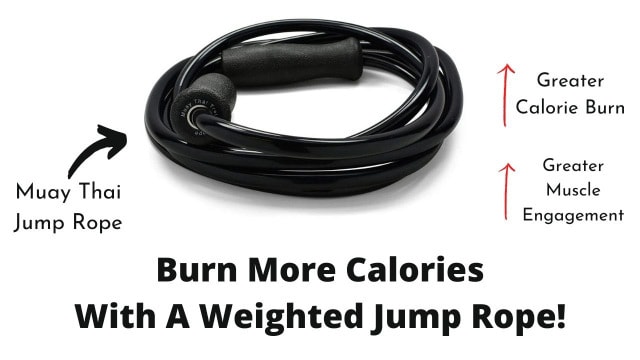When I first started jumping rope, I was getting headaches all the time. I’d be jumping for only a few minutes before my head started pounding. It was the worst! Fortunately, I was able to figure out why and fix it.
Why does jumping rope give me a headache? The exact cause of jump rope headaches, also known as exercise headaches, is unknown. However, many theories suggest they stem from dilated blood vessels in the skull. Other factors, including dehydration, poor diet, hot weather, and altitude can play a role as well.
These headaches typically occur during strenuous exercise like weightlifting, running, martial arts, etc., and less conditioned athletes are usually at higher risk.

It’s a complex issue that requires further explanation. Let’s explore a few of the more common causes and how you can combat them, so you can get back to training.
Potential Causes for a Jump Rope Headache
Over-training
Over-training, or not allowing your body to recover after strenuous activity, can do a number on your body. There are a huge number of symptoms associated with over-training, headaches included.
It should be pretty apparent if over-training is the cause for your jump rope headache. If you’re training 6-7 days per week and experiencing a decrease in performance, constant fatigue, or low sex drive, chances are you’re over-training.
One the best ways to stay healthy during an intense training regimen is to eat a well-balanced diet. It’s important to give your body the nutrients it needs to recover.
And, while I personally don’t take many supplements, I do take Branched Chain Amino Acids (BCAA). Taken after a workout, BCAAs jump start protein synthesis which plays a vital role in the body’s ability to recover.
New to Jumping Rope
If I were to guess, this is probably what’s causing a headache for most of you…
When introducing your body to a new exercise or sport, it takes some time for your body to adjust. Aches, lactic acid build up, cramps, these are all side effects of demanding more from your body. The good thing is they’re only temporary. Work hard, be consistent, and be patient, the headaches will go away.
High Blood Pressure
Hypertension, or high blood pressure, puts people at risk for a variety of issues like heart disease, heart attacks, and stroke. There’s also a lot of evidence suggesting a strong correlation with headaches.
Hypertension is most common in the elderly, African Americans, smokers, and obese or overweight people. That said, it can effect just about everyone. While the evidence is not conclusive, finding ways to keep your blood pressure in check is a great way to avoid jump rope headaches.
Dehydration
One of the most common reasons for experiencing a headache while jumping rope is simply due to a lack of fluids. As you sweat, those fluids need to be replaced in order for your body to function properly.
For me, remembering to drink water throughout the day is a challenge. I’m the worst at it… I actually went out and got myself a smart water bottle recently (Smart Water Bottle, by Icewater) to remind myself to hydrate. It’s actually pretty cool.
Stress
Headaches from stress are typically more mild, usually start later in the day, can cause sensitivity to light or noise, and give you trouble sleeping. They’re usually easy to decipher from a jump rope headache.
Although fairly different from a jump rope headache, stress headaches are important to consider if you’re experiencing constant headaches when jumping rope.
Alcohol Consumption
Drank too much last night? Most of us know what a hangover feels like and can identify one when we’re experiencing it. Still, it’s important to think about how much alcohol you’re consuming if you’re getting a headache when you jump rope.
Not only is the main ingredient in alcohol, Ethanol, correlated to headaches and migraines, but alcohol consumption also causes dehydration, another trigger to an exercise headache.
Hot Weather / High Altitude
The link between weather and headaches is an interesting one. Various whether elements, such as temperature, air pressure, and humidity, have all been proven to cause an increase risk of headaches.
A study, of over 7000 people, found that the risk of headache increased by 7.5% with as little as a 9 degree Fahrenheit increase in temperature. Like me, you might attribute that to dehydration. However, well-hydrated people also showed an increased risk.
Altitude was also tested in this study, linking lower barometric pressure to increased risk for headaches.
Now that you know what’s likely causing your headache, you’re probably wondering what you can do about it. Don’t worry! I’ve been in your shoes and there are some simple things you can do to fix it.
Consider Picking Up a Weighted Jump Rope
If you’re looking to burn more calories, experience greater muscle engagement, and get an overall better workout, you might consider picking up a weighted jump rope.
The Muay Thai Jump Rope, from EliteSRS, is the weighted rope I use.
10 Ways to Prevent Jump Rope Headaches
Identifying the specific cause of an exercise headache can be tricky, however if you’re able to make some of these minor lifestyle changes I’m confident you can get rid of it.
- Better Sleep: There is a lot of evidence suggesting lack of sleep is correlated with headaches. Without a good night’s rest your body and brain will struggle to function properly. (Shoot for 7-8 hours each night)
- Fix Posture: When you’re hunched over, with your back and neck in an unnatural position, the muscles of the face and head become strained making headaches more common. (Try and focus on proper posture throughout the day, head up and shoulders back)
- Hydrate: This is a big one! For me, drinking an extra couple of glasses of water each day was all I needed to get rid of my jump rope headache. (Shoot for 11 cups each day for women, and 15 cups for men)
- Improve Diet: One of the more popular theories why jump rope headaches happen is the dilation of blood vessels in the skull. If you have high blood pressure it’s possible that’s what’s causing your headache. (Try to limit smoking, reduce sodium, and stick to a diet low in saturated fat)
- Reduce Stress: This goes way beyond just getting rid of a headache. It’s critical to make time for yourself, relax, spend time with friends and family, laugh, listen to music, etc. Find balance in your life and the stress and associated headaches will disappear! (Try a yoga class)
- Limit Alcohol: There’s nothing wrong with an occasional glass of wine or beer with dinner. That said, binge drinking can do a lot of damage to your brain and body. (Sober October?)
- Stay Cool: Heat exhaustion and heat stroke is no joke! And, when working out in a hot environment, headaches are usually one of the first signs. (Take a break from the sun, find some shade, and drink lots of fluids)
- Exercise: It might seem contradictory, given exercise is what gave you the headache in the first place, but there is a clear association between low levels of physical activity and an increase risk of headache. (If you’re new to exercising, it may take some time…be consistent)
- Limit Caffeine: It’s possible to mistake a caffeine headache for a jump rope headache. Whether you’re drinking too much caffeine or withdrawing from it, you might consider reducing your caffeine intake. (I drink 1 cup of coffee per day, then switch to tea)
- Listen to Your Body: Head colds, fever, sinus and ear infections, these are all issues that can lead to a headache. Make sure you’re not attributing your jump rope headache to an illness. (Listen to your body and rest when you need it)
When to Consult a Doctor
In rare circumstances, headaches can be a sign of something more serious. While you’re most likely experiencing a headache for one of the reasons listed above, it’s incredibly important to keep an eye out for any unusual symptoms.
Surprisingly, certain kinds of headaches can be related to a tooth or gum infection, head injury, brain tumor, and even cancer. Again, it’s very unlikely, but important to be aware of nonetheless.
If you’re experiencing any of the following symptoms, or had a recent head injury, it’s crucial to get medical help immediately.
- Sudden severe or share head pain
- Slurred speech
- Hearing difficulty
- Trouble walking
- Blurred vision
- Fever higher than 102 F
- Stiff neck
- Night sweats
- Numbness or tingling in the face
- Confusion
- Vomiting or nausea
- Fainting or dizziness
- Seizures
- Head Swelling
- Nosebleed
- Pressure in your head
Related Questions
What is a good alternative to jumping rope? There’s a variety of great jump rope alternatives, including burpees, jumping jacks, and high knees. Your reason for finding an alternative will determine which one is best. Jumping jacks are a little lighter and less strenuous, while burpees are more challenging.
7 Great Alternatives to Jumping Rope
Is jumping rope better than walking? Jumping rope provides greater cognitive and cardiovascular benefits than walking. It also increases bone density and strengthens the feet in ways walking does not. Additionally, jumping rope burns significantly more calories than walking. On average, you burn 800-1000 calories jumping rope for an hour compared to 150-300 calories walking.
Best of luck!

